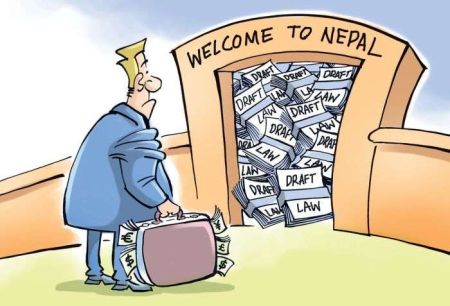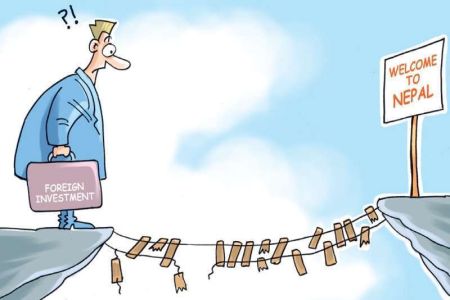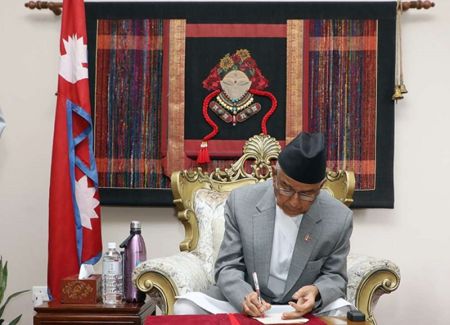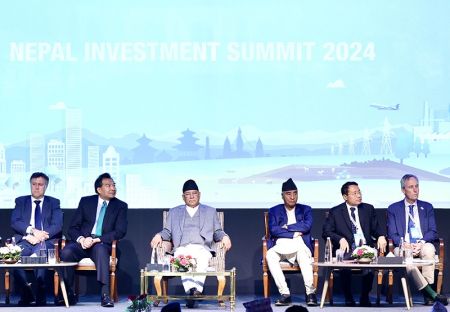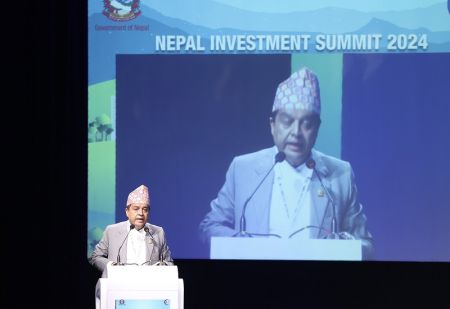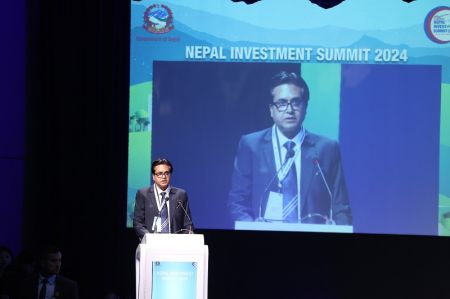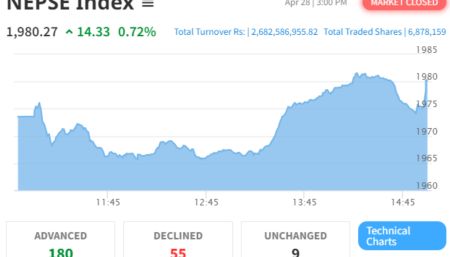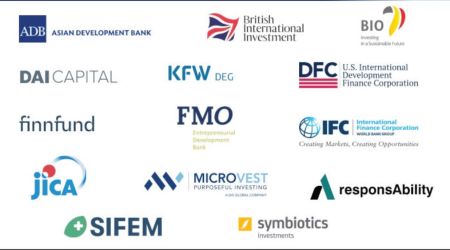By Pinaki Roy
Public corporations in Nepal will receive subsidies in excess of Rs 2.77 billion in the fiscal year (FY) 2011-12. According to the budget announced on 15 July this year by Finance Minister Bharat Mohan Adhikari, the government will provide over Rs 1.77 billion to the state-owned enterprises (SOEs) as subsidies in the current financial year while another Rs 1 billion will come in as foreign grant and loan. The subsidies to the SOEs for FYs 2009-10 and 2010-11 stood at Rs 1.54 billion and Rs 1.97 billion, respectively.
Public corporations in Nepal will receive subsidies in excess of Rs 2.77 billion in the fiscal year (FY) 2011-12. According to the budget announced on 15 July this year by Finance Minister Bharat Mohan Adhikari, the government will provide over Rs 1.77 billion to the state-owned enterprises (SOEs) as subsidies in the current financial year while another Rs 1 billion will come in as foreign grant and loan. The subsidies to the SOEs for FYs 2009-10 and 2010-11 stood at Rs 1.54 billion and Rs 1.97 billion, respectively.
Most SOEs in Nepal are in loss for a long time now. Even the ones that are making profits are because of their monopolistic nature of business. However, it’s inevitable that they too stand to come under pressure once competition intensifies. For example, Nepal Telecommunications Corporation (NTC) is being increasingly challenged by Ncell, a leading mobile telephony brand in Nepal. Most SOEs that are registering mounting losses year after year owe it mainly to political interference and corruption within these public corporations. The high profile Nepal Electricity Authority (NEA), Nepal Oil Corporation (NOC) and Nepal Airlines Corporation (NAC) are among the notable SOEs that have been making losses for as long as one can remember. Suresh Kumar Regmi, Under Secretary at Corporation Coordination and Privatisation Division of the Ministry of Finance (MoF) says, “The corporations must try to become profit making entities on their own instead of expecting help from the government all the time.â€
Keeping these SOEs alive and kicking essentially means that the state has to dig deeper into its coffers to provide for them. The same money could have been invested otherwise on development. Among the most glaring failures are those of NEA and NOC that have miserably failed to adjust prices in accordance with evolving market dynamics. NEA sells electricity to its consumers at Rs 6.57 per unit as against its cost of Rs 8.97 per unit resulting in a loss of Rs 2.40 per unit. Its accumulated loss of around Rs 19.47 billion exceeds several folds to its total asset value. Similarly, NOC is under Rs 15 billion deficit currently due to heavy losses on petrol, diesel, kerosene and liquefied petroleum gas (LPG) prices. To make matters worse, it is plagued with corruption, political interference and poor governance. The government has no choice but to bailout these SOEs year after year because electricity and fuel are basic services that people of this country cannot be expected to live without.
The question arises as to how long can the state rescue the loss-making SOEs by compromising on development expenditure. NAC – once the pride of the nation – has gone from bad to worse with losses amounting over Rs 2 billion. Boasting a sizeable fleet of 21 aircraft at one point of time, it is left with only three small aircraft that fly domestic routes and two medium sized jets. Among the biggest foreign currency earners not too long ago, NAC today merely watches in despair other domestic and international airlines snatching away its market share. Never-ending controversies on aircraft purchasing, political meddling with appointment of staff and loans have hit the corporation hard in the recent past. The employees appointed by the public enterprises (PEs) stood at 33,603 in FY 2008-09, while this figure dropped slightly to 33,526 in the succeeding fiscal year. The average monthly expenditure of these employees reached Rs 34,126 in FY 2009-10.
The taxpaying populace is infuriated because its money is funnelled into these failed enterprises while development activities and service delivery are taking a beating due to, among others, inadequate funding. Furthermore, there has been a lack of genuine intent to reform or privatise the loss making enterprises. The SOEs’ survival now stands purely for political reasons. Their existence does not add significant value to the country’s productive capacity. During FY 2009/10, 22 PEs earned net profit, whereas 14 PEs recorded loss; some of them had negative net worth. The government’s investment in these SOEs has reached a whopping Rs 84.91 billion.
The total operating income of these enterprises in FY 2009-10 registered an increase of 21.63 per cent over the previous FY and reached Rs 130.98 billion. While the operating income of service sector enterprises increased by 70.2 per cent, the industrial sector enterprises registered the least increase in operating income at 4.2 per cent. The net fixed assets of 36 enterprises that totalled Rs 133.740 billion in the fiscal year 2008-09, reached Rs 139.365 billion by the end of the fiscal year 2009-10, an increase of 4.2 percent. While analysing the entire profit and loss of the 36 PEs, the net profit of Rs. 10.55 billion they had earned in fiscal year 2009-10 grew by Rs 8.3 million in the fiscal year 2010-11. However, if three major profit making SOEs are taken out, these statistics cut a sorry figure in itself.
Akin to the case in other countries, the state enterprises in Nepal too are present in areas that could be more successfully occupied by the private sector. Incompetent SOEs have blocked private dynamism completely and, at the same time, necessitated an insurmountable financial and administrative burden. In contrast, privatisation promises to free up public assets for activities of urgent attention and facilitate improved and inexpensive services besides unlocking prospects for private sector growth. However, the Privatisation Cell of the MoF has no immediate plans to privatise SOEs anytime soon. “We are not in a position to close loss making enterprises either as they provide employment to thousands of people,†Regmi informs on a rather helpless note.
Nepal’s privatisation programme articulated in the 9th plan envisions promoting private sector participation in the economy. A number of enterprises, mostly agricultural and industrial, have been privatised since the programme began in 1992 with the government playing the role of a catalyst. However, a number of productive SOEs such as Bansbari Leather and Shoes Factory (BSLF) and Agricultural Tools Factory (ATF) have ceased to function after being privatised owing to government’s thoughtlessness in selection modality and consultation process, and lack of proper homework while selling them. Over the last decade or so, the privatisation drive has slowed down considerably to the extent of coming to a virtual standstill.
The delicate financial health of the SOEs and their failure to adequately gratify market demands is a persistent problem that cannot be resolved by gifting subsidies and granting loans. Mismanagement, overstaffing, poor governance and accountability, competition from private players and most importantly, politics prevailing over economic imperatives have destroyed these SOEs and led them to their present dismal state. One can safely assume that unless there are radical and wholesome practices pursued such as privatisation (save the ones that are strategically linked to critical security and national interests) of these ailing enterprises, the SOEs will continue to be resigned to their fate and the taxpayers of this country will keep on bearing their burden. Worse, bailing out the SOEs of their financial chaos time and again only makes them more inefficient. It’s but tragic that the sick enterprises are encouraged to take the state and the nation at large for granted.
The Loss-making SOEs
| Name of the SOE | Total Loss |
| Dairy Development Corporation | Rs 325.1 million |
| Herbs Production and Processing Company Ltd | Rs 136.2 million |
| Hetauda Cement Industry Ltd | Rs 619.8 million |
| Janakpur Cigarette Factory Ltd | Rs 800.8 million |
| Nepal Drugs Ltd | Rs 485.8 million |
| Udaypur Cement Industry Ltd | Rs 1.773 billion |
| Nepal Oriental Magnesite | Rs 3.597 billion |
| Nepal Food Corporation | Rs 1.107 billion |
| Nepal Oil Corporation Ltd | Rs 8.418 billion |
| Nepal Airlines Corporation | Rs 1.557 billion |
| Gorkhapatra Corporation | Rs 89.7 million |
| Nepal Television | Rs 760.2 million |
| Nepal Water Supply Corporation | Rs 391.4 million |
| Nepal Electricity Authority | Rs 18.230 billion |
| Agricultural Development Bank Ltd | Rs 4.391 billion |
| Rastriya Banijya Bank Ltd | Rs 11.228 billion |
Source: Ministry of Finance Report, Ashad 2068









